Keyword Research helps you find relevant content for Ideal Customer Profile (ICP).
Learning how to do keyword research, helps you rank content on search engine pages. It helps you drive organic traffic, assess SEO campaigns, and convert users into paying subscribers.
Here is what you’ll be learning in this resource.
- What is Keyword Research?
- Different ways to perform Keyword Research
- How to do Keyword Research?
- Create SEO optimized content to rank high on Google
Let’s get started.
Keyword Research
What is Keyword Research?
In a specific industry, keyword research helps users find relevant topics.
Let’s describe the subject from a different angle.
Look, the purpose of content creation is, to drive organic, real, natural traffic from search pages.
In this case, the more coming users are relevant, the better you can convert prospects into paying subscribers.
To achieve relevancy, conversion, and increase revenue, the process of keyword research involves finding keywords people are searching for on Google, let’s say – the topics tailored towards Ideal Customer Profile (ICP).
To this line, you should’ve understood, what the process of keyword research consists of for users.
Let’s proceed further.
Before diving deep into the subject, you need to understand first, what does a Keyword mean in SEO?
What is a Keyword?
In simple words, a keyword refers to a search phrase people use to enter in search engines.
Technically, here is what a keyword can show us.
- A keyword helps us understand users’ intent on search engines. It helps us figure out, if a user is looking for informational content, advice, or wants to buy a specific product.
- Keywords on search engines help us confirm, if a phrase really exists. For example, if a keyword is listed in Google’s Autocomplete suggestions, we can pick the keyword and proceed further.
In short, let’s discuss the types of keyword for various search intents.
- Informational Keywords – help content creators understand, people are searching for advice on search pages.
- Commercial Keywords – show users’ interest to buy some products.
- Navigational Keywords – as its name suggests, such keywords help users navigate to a specific site, brand, or source on the Internet.
- Transactional Keywords – helping users complete an action, such as signing up to a website.
Note: SEO candidates, such as Semrush, can help you identify a phrase search intent. Once you have a list of keywords in Semrush, the “search intent” column shows relevant intents for keywords.
Purpose of Keyword Research
Don’t proceed blindly. The process of keyword research needs careful attention.
Remember – keywords can make or break your site’s success, content strategy, and the future of pages on search engines. Period.
In simple words, here is what the purpose of keyword research ensures.
- The process of keyword research helps us gain Return on Investments (ROI). Simple. In this case, you don’t need random traffic to make money, you need to drive relevant, organic traffic from search engine pages.
Hence, a stream of new visitors from organic traffic, is what helps you convert readers into paying customers. Organic visitors are ideal for conversions. They have a problem, search for on Google, find your site, and reads your content, feels relevant, and buys your products or services.
In this case, two things should make sense.
- The keywords you find should address a specific audience’s needs, problems, and interest.
- The content should provide solutions to readers’ problems.
To this line, you should have understood, what the process of keyword research should feature.
However, you need to understand more in details.
Let’s proceed further. Pay attention.
Ideal Keyword Research
How can you measure, if the process of keyword research has gone ideal?
Look – here is what confirms the effectiveness of the process.
- Make sure, the process of keyword research helps you find relevant search phrases. If a keyword is not relevant, how can you attract relevant audience, the audience searching for relevant ideas on search engines. Simple math.
- The keywords help you secure search rankings – if the phrases are easy-to-rank on search pages. Remember, you should make sure, the content you publish should drive organic traffic.
- You shouldn’t find random content ideas. In this scenario, look – if the keywords don’t mean to convert, what’s the point. So, make sure, the keywords you find are tailored towards your offer, products, or services.
- Validate keywords before you’re ready to create content. In this regard, make sure – the keywords you pick show up in Google’s autocomplete suggestions. Second, the keywords you pick should have a decent search volume. So, a keyword’s search volume helps you confirm, people on search engines are searching for the keyword. Keep in mind, the more a keyword has a high search volume, the more the keyword is hard to rank on search engine. On the other hand, you can also pick keywords having a search volume 0, if the keyword is purely suggested by Google. In this case, you should consider a rule of thumb. Listen, if Google is suggesting a phrase, people are searching for on Google, even, if the phrase has a 0 search volume, according to SEO candidates.
How to do Keyword Research?
Listen carefully.
Before you start the process, consider the following concerns.
- Take care of the keywords’ types. Decide, what type of keywords you are eager to find.
It depends.
For example, as described above – you can find informational, commercial, navigational, or transactional phrases.
It depends on the end goals of content creation. You can feel the subject matter. Perfect.
- Second – you’ve to go through the process of competition analysis. It helps you figure out, if you can rank for a keyword on search pages.
In the coming lines, we’re exploring the process of competition analysis.
Let’s come back to the point.
In this resource, we’re going to explore two methods of keyword research.
- Manual keyword research
- Finding keywords using Competitor analysis
There is a different approach of keyword research, too.
If you know your niche well, you don’t need to do keyword research. In this regard, you can randomly compile content ideas. The point is, you know what people are searching for on search pages. You know your audience. In this case, you don’t make sure, the process of choosing keywords should pass a specific routine, such as competition analysis. Instead, creating helpful content helps you drive organic traffic via related phrases. For example, if a piece of content is correctly serving readers, Google ranks and let you drive organic traffic.
Let’s dive deeper.
Manual procedure
Introduction
As its name suggests, manual procedure includes finding relevant content ideas using manual routines.
In this case, a person’s manual knowledge weighs more importance – no doubt.
In this procedure, using Search pages make more sense. For example, obtaining a list of relevant phrases from search pages, helps you find relevant ideas for content.
Advantages
Of course, there are benefits of manual procedures to find ICP ideas for content.
Let’s discuss further.
- Manual procedure helps you understand, what’s happening behind the scenes. Perfect.
- You don’t have to spend money, if you know how to find keywords manually.
- You can better understand a keyword’s metrics – such as search intent, trend on search pages, traffic potential, and competition if you know how to assess keywords, manually.
Disadvantages
Manual routines have some disadvantages too.
- If you don’t know how manual routines in SEO work, manual research is not ideal for you.
- Manual research takes Time, yes.
- It requires efforts to find keywords manually. Unlike automation – finding a single keyword manually, can take hours.
Process
Let’s discuss – how can you find keywords manually, step by step.
Step 1: Fire up Google
Open Google. Let’s find some keywords, manually.
In this case, we’re going to let Google show us relevant search phrases. Keep in mind, the Google’s search result pages (SERPs) can shows us related search phrases.
Instead of Google, you can use Bing, if makes sense for you.
Step 2: Enter a Seed keyword
A seed keyword refers to a main search phrase in a niche. It is also called a primary keyword.
For example, a well-known topic people are discussing in a niche, is referred to a seed keyword.
Now, we need to enter a seed keyword in Google.
Here, on Google – you can enter variations of a seed keyword. You can also try different angles for a search query.
For example, instead of entering a declarative seed keyword, try entering question words.
Here – the purpose of entering variations is to fetch various search query styles from Google’s database. Perfect.
Here is what happens if you’ve entered a seed keyword in Google. The following screenshot shows a sample search in the WordPress niche.
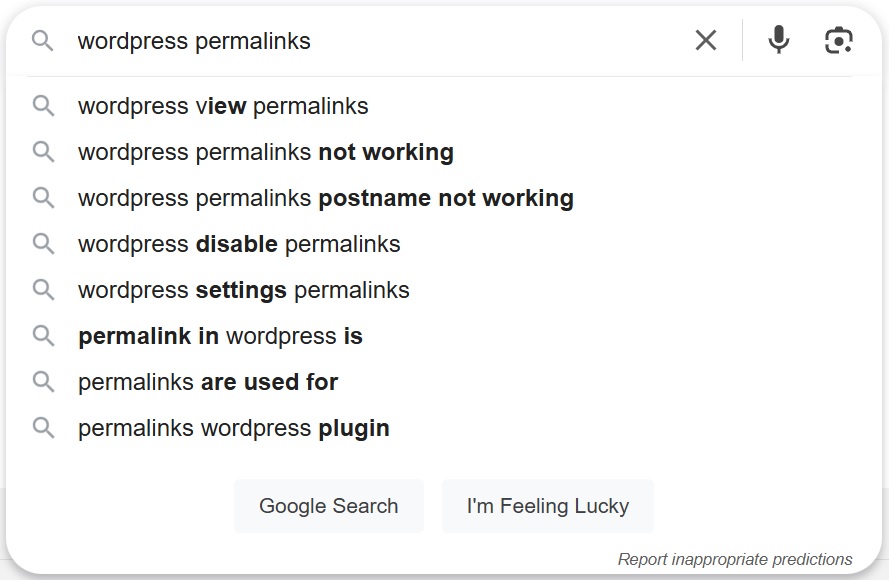
Step 3: Google Autocomplete and Related Searches
On Google’s SERPs, we need to focus on two places.
First – Google’s autocomplete suggestions include relevant search suggestions. In this regard, the autocomplete feature refers to the list of related search suggestions Google shows, once you start entering a seed keyword.
Here is the screenshot of Google autocomplete feature.
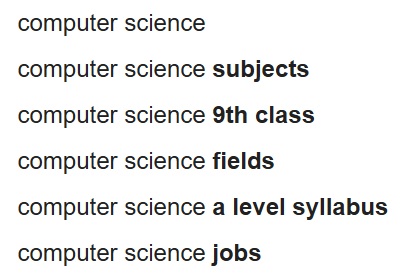
Second – the search suggestions at the end of a Google search page refers to “related queries”, helping us find related search phrases for a main keyword.
Here is how the related search section displays on Google.
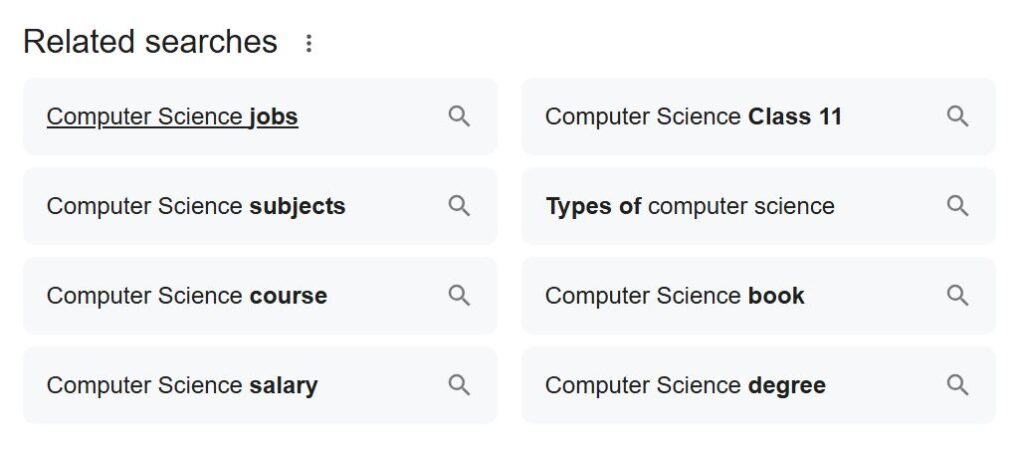
The point of impact is to get a list of related search suggestions for a seed keyword.
In this scenario, Google autocomplete and related search sections, help you manually fetch Google’s keywords. Perfect.
Let’s proceed further.
Step 4: Competition Analysis
Now – you’ve a list of related search suggestions, let’s proceed further.
In this section, we’re going to figure out, if the search suggestions are making sense for us.
In this step, we need to understand the following two aspects in the trade.
- We need to pick most relevant search phrases, the ones seem fascinating to us. You can call such keywords as leads, proposed, or ideal search phrases.
- And, second – we will need to figure out, if we can rank for the keywords we pick.
So, basically – the process of assessing a keyword’s rank-ability is called Competition Analysis.
This process requires special attention. It can build or hurt your ranking expectations, remember.
Let’s proceed further.
Look – once you’ve picked ideal keywords, here is what you need to do.
- Load the Google SERPs for keywords, one by one – and assess the ranking competitiveness of keywords. It helps us see, if there is a ranking opportunity possible.
- Second, perform a strategic, technical, and manual routine to decide, if we should or can pick certain keywords.
Let’s describe the subject in more details.
Once you’ve loaded a search phrase’s Google SERP, here is what to look for one by one.
- Relevancy
Look, see if the ranking sites have satisfied the search query’s search intent.
In simple words, see if the ranking sites are on point, have covered the topic’s relevancy correctly.
Here, there are two situations.
First – if the ranking sites are relevant, have satisfied the search intent, and are on point – you will need to pick a different keyword for competition analysis. Simple. In this case, you can confirm by thinking from a user’s perspective and load the page to see, if the ranking sites have covered solving readers’ expectations.
Second – if the ranking sites are weak and have not covered readers’ intent and relevancy, you should check the next check for the search phrase.
Let’s proceed further.
- See the content’s quality
Now, let’s suppose the ranking sites are weak, as discussed above, you need to see if the content quality is weak as well.
If weak, you’re good to check the next point. If not weak, for example, you can still check the next point for the search query.
An example of a weak content page refers to one having less content on page.
- Analyze DA and Referring domains for the ranking page
Now, you need to install the Moz extension in Chrome to check for a page’s DA and referring domains.
Domain Authority (DA) helps you see if a site is authoritative to rank based on pointing backlinks. Here, the more a site has a high DA, the more difficult it is to outrank.
Second, referring domains refer to pointing backlinks or domains to a page. In this case, if the ranking pages have a high number of pointing links, the more harder it is to outrank the page.
Now, see if there are low stats for the ranking pages, especially for the first 3-5 slots on Google.
If yes, you have found a low competitive keyword. If no, you can still target the keyword if, the above two attributes are making sense for you.
Finally, you’ve learned how to assess a keyword’s competition manually, after you have obtained relevant keywords from Google.
The more you repeat the process, the more you can find relevant keywords, manually. Perfect.
Competitor Analysis
Unlike manual procedure to find search phrases, the process of competitor analysis provides automation.
First – learn what a competitor is in SEO.
A competitor refers to a similar, relevant site in your niche.
Here is what to look for a site, if you need to decide if a site is similar to your business.
- The site should sell the same types of products or services you’re promoting.
- It would be good, if a competitor is at same level as you’re currently. It helps you forecast, if you can outrank existing content ranking on search pages. Here, the level is measured by DA score.
Let’s proceed further.
Introduction
Competitor Analysis consists of finding competitors’ keywords.
The philosophy is simple.
If, on search pages, one of your site’s competitor is ranking for relevant keywords, you can rank as well.
So, if you find competitors’ keywords, you can create similar content to rank on search pages – simple.
Advantages
In SEO, competitor analysis helps you forecast success rate.
In this scenario, you can forecast, if creating content on competitors’ keywords makes sense.
In simple manner, competitor analysis helps you know, if you can specifically rank for a similar phrase. Perfect.
Disadvantages
You may need to use SEO candidates for competitor analysis.
However, free tools can help you avoid spending money on premium services.
Second – competitor analysis can make you lazy, if you’re doing SEO for a living. Hence, automation is helping you fetch competitors’ keywords, manual knowledge is left concealed in dark – untouched.
Similarly, an SEO tool may fail to fetch competitor’s data if the site is young. In this case, you can skip and proceed to pick a new competitor URL.
Let’s proceed further to the action part.
Process
Step 1: Find a Competitor URL
Finding a competitor’s site is easy.
You can pick one from Google. In this case, type in a relevant phrase in Google, and pick a site from the ranking ones.
Here, a simple rule of thumb is working.
The sites struggling to rank for the same phrases you’re trying to rank for on search pages, are the ones you can call your site’s competitors. It makes sense to understand.
Second, Semrush can help you find your site’s competitors. Enter your site address in Semrush, and the competitors tab helps you list your site’s competitors. Simple.
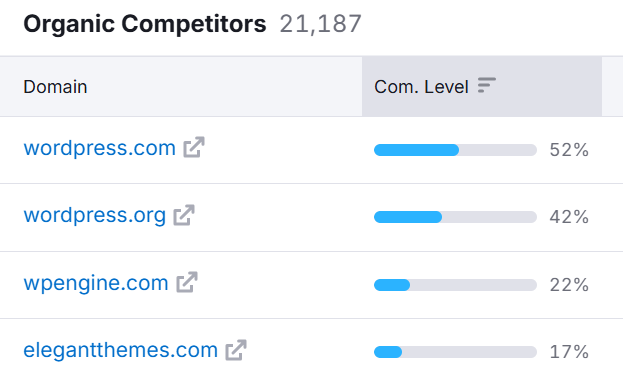
Here, if you can’t afford to use Semrush, use Similar Web – helping you find several competitors for free. You can enter your site’s URL or a competitor’s address, and the system lists competitors.
To this line, you should have learned how to find your site’s competitors.
Now, listen carefully. You need to validate if picking a competitor’s URL makes sense.
Here is what you should consider.
- Make sure, the site you pick as competitor is relevant. Visit the site’s home page and see if relevant. Second, enter the site’s URL in Google and see, if meta tags are relevant to your site.
- Second, pick competitors struggling at a similar level as you’re currently. As mentioned above, the level of a site is determined by Domain Authority Score (DA). Invented by Moz, a site’s DA score from 1 to 100, shows how likely a site is able to rank on search pages.
To proceed, find your site’s DA first. Use the Moz chrome extension.
Next – you have to make sure, the sites you pick as competitors should have the same DA score, or lower is better.
For example, if your site’s DA score is 20, pick competitors having a DA score of 20 or less.
Now, to this line – you should have learned how to find your site’s competitors. Perfect.
Let’s move forward to the next step.
Step 2: Find Top Pages
In this step, you’ve to find your site’s competitors’ top pages.
What are top pages?
Top pages on a site drive maximum organic traffic. The top pages on a competitor’s sites help you understand proposed content ideas.
To find top pages on a site, here is how you should proceed further.
SEO candidates, such as Semrush, Ahrefs, or Uber suggest help you find a site’s top pages.
Simply put, enter your competitor’s URL in a tool. The next screen should feature an option to find the top pages.
Once used, you should see a list of top pages on competitor’s site. Tools can also display specific Tabs for top pages. Here, you can play around various options, such as picking pages ranging specific search volume, traffic, or content length. It depends on requirements.
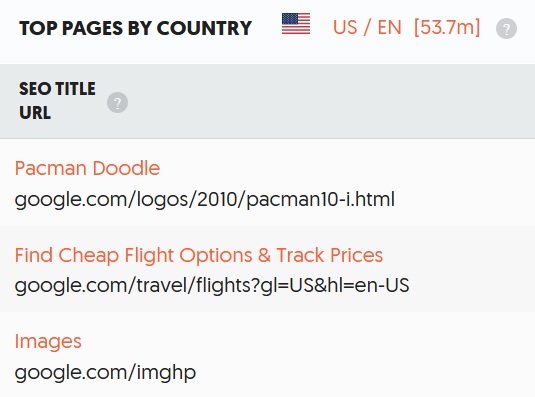
Here, you need to have a list of ten pages. Export the list.
Now, let’s proceed to the next phase.
Step 3: Focus Keywords
In this step, we need to find focus keywords for the pages we exported.
Here is what you should understand about focus keywords.
- A focus keyword shows the main, primary, or seed keyword of a page.
- In general, a focus keyword refers to one driving maximum organic traffic to a page.
- In simple words, a focus keyword helps a page rank in the Google’s top 3 positions.
Let’s proceed further.
Above – the way you found competitors’ top pages, you can find focus keywords of pages, too.
Here is what happens.
The SEO candidates can also help you see focus keywords for a page.
Once entered a page’s URL in Semrush, let’s say – pick the keyword(s) driving maximum traffic to the page. Second, if a phrase is causing rankings in the Google’s top 3 positions, pick the keyword(s).
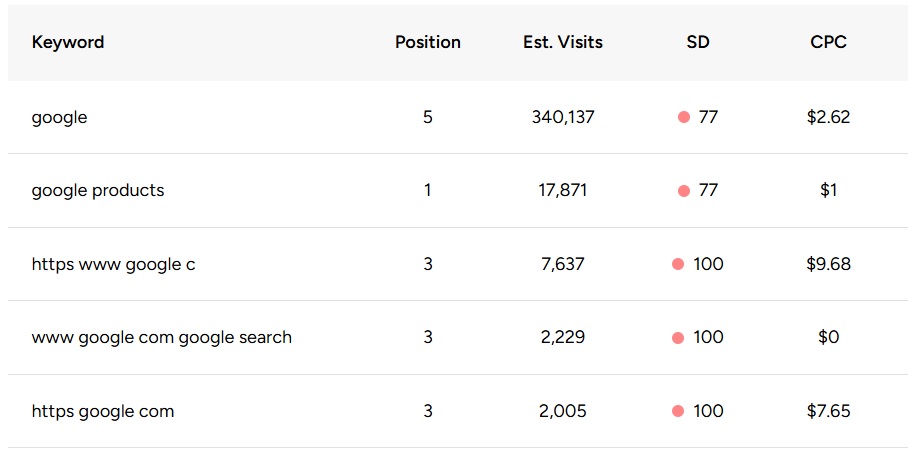
In this manner, you should have a list of top pages, along with focus keywords for each URL. Perfect.
Now, here is a rule of thumb. It shows you, why did you pick top pages, and found focus keywords.
If a page on competitors’ sites, on a specific focus keyword, is ranking on Google, you can rank as well, if created content on the same keyword. Second, the statement is true if you’ve picked a competitor based on similar DA metric.
Next, let’s proceed further to the next step.
Content creation
Note: If your site is new, make sure to keep creating content for the first several months. However, it doesn’t mean spam. You should create helpful, detailed, and content for readers’ expectations. The point of impact is, search engines don’t trust new sites. It would be good if you keep publishing quality content, once you’ve launched your blog. Second, for young sites – you can focus more on finding low competitive content ideas. Such phrases help you quickly secure rankings on search pages.
Note 2: Keep in mind, the process of doing keyword research has ended. You should have a list of ideal topics in hand. Now, the process of content creation shows the next step.
Now – once you’ve researched ideal keywords, we’re ready to create content. At this point, you should have used manual routine to research content ideas, or used competitor analysis for research.
Where are the seed keywords? The keywords we found using manual routine, collected from Google SERPs – or the focus keywords we just found are the main keywords for content creation – simple.
Based on what ranking pages have covered, create 10x better content to rank high on Google pages.
In this case, 10x content refers to content 10 times better than competitors.
Here is what you should consider.
- Create relevant outlines. See the currently ranking pages on Google. See what they’ve covered, create better content than competitors.
- Take care of content relevancy, search intent, readers’ expectations, and conceptual flow.
Here, let’s not over complicate the process of content creation.
Listen – once you’ve created content, you should feel satisfied – no doubt. There should be no fluff added to content, pure advice based on the readers’ expectations, search intent, and content angle.
Next, publish the content and make sure, you’ve submitted the piece of content to Google Search Console. It helps you let Google crawl the new page quickly.
Perfect.
After you’ve published the content, here is what you should keep in mind.
- Remember, a new page takes 2 to 2.5 months to stabilize on search pages. The duration of time helps you understand, during this period, Google can appear or disappear your page from search pages – normal routine.
- Once submitted to GSC, have an eye on the discovery of URL, crawling status, indexing, and finally, ranking of the page on search pages.
- Once Google has ranked a page, start measuring impressions, CTR, and ranking positions for the page. The stats help you decide, how should you improve a page’s relevancy.
To this line, you should’ve learned how to find relevant keywords from competitors.
Final words
Congratulations, if you’re reading this far.
In this resource, I’ve put together the exact routines I used to research relevant keywords. And, needless to say – I’ve thousands of keywords ranking high on search pages.
Remember – doing effective keyword research is not rocket science. However, the process is critical and requires SEO knowledge of what’s happening behind the scenes.
Here is the recap of the resource.
- Manual routine helps you research relevant content ideas manually, doesn’t require fancy Tools. It requires manual knowledge of SEO, no doubt. Keep in mind, if you’re a beginner – don’t start with manual procedure. Sure, it can help you save money; however, if you’re not smart enough in SEO, don’t proceed. The steps we perform in manual procedure requires expertise.
- Second, competitor analysis helps you fetch content ideas from competitors’ sites. The process requires SEO automation to fetch data. In this regard, the more relevant a competitor is, the better you can fetch relevant data.
What are the next steps?
Next steps
Even, if you prefer researching competitors, make sure, you know the manual routines of doing Keyword Research. It helps you stay forward of the crowd. For example, Tools can’t help you correctly assess a keyword’s competition on search pages, manual knowledge can help. You can feel the difference.